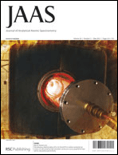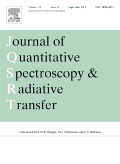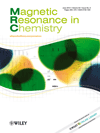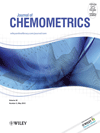
JOURNAL OF NEAR INFRARED SPECTROSCOPY
Scope & Guideline
Connecting Researchers through Spectroscopic Discoveries
Introduction
Aims and Scopes
- Application of Near Infrared Spectroscopy in Food Quality and Safety:
The journal emphasizes the use of NIR spectroscopy for monitoring and predicting various quality parameters in food products, such as moisture content, chemical composition, and sensory traits. This includes studies on fruits, vegetables, and processed foods. - Environmental Monitoring and Soil Analysis:
Research often explores the application of NIR spectroscopy in environmental studies, particularly in assessing soil health and contamination levels. This includes the prediction of organic carbon content and the detection of pollutants. - Integration of Chemometrics with Spectroscopy:
A significant focus is on the development and application of chemometric techniques to enhance the interpretation of spectroscopic data. This includes multivariate analysis, machine learning, and calibration transfer methods. - Non-Destructive Testing and Quality Control:
The journal highlights non-destructive methods for assessing the quality of various materials, including agricultural products and industrial goods. This aspect is crucial for real-time monitoring and quality assurance in production. - Innovative Instrumentation and Techniques:
It features advancements in NIR instrumentation, including portable devices and novel methodologies that improve the accuracy and efficiency of spectral analysis.
Trending and Emerging
- Machine Learning and Artificial Intelligence Applications:
There is a significant increase in research that combines NIR spectroscopy with machine learning and AI techniques. This trend aims to enhance predictive accuracy and model robustness across various applications, from agriculture to food safety. - Hyperspectral Imaging:
The use of hyperspectral imaging in conjunction with NIR spectroscopy is on the rise, allowing for more detailed analysis of materials and improved classification capabilities, particularly in food and environmental studies. - Real-Time and In-Situ Monitoring:
Emerging studies focus on real-time monitoring applications, utilizing portable NIR devices for on-site analysis in agricultural and industrial settings, which enhances the practicality of spectroscopic methods. - Sustainability and Environmental Impact Assessments:
Research is increasingly addressing sustainability issues, with NIR spectroscopy being applied to evaluate environmental impacts, soil health, and resource management, reflecting a broader societal emphasis on sustainability. - Integration with Other Spectroscopic Techniques:
There is a growing trend towards integrating NIR spectroscopy with other spectroscopic methods (e.g., Raman, UV-Vis) to provide complementary data and improve the overall analytical capabilities.
Declining or Waning
- Traditional Spectroscopic Methods without Advanced Analysis:
Papers focusing solely on traditional NIR methods without integrating modern chemometric or machine learning techniques have become less common, as the field moves towards more sophisticated analytical approaches. - Basic Agricultural Applications:
While agricultural applications remain important, there has been a noticeable decrease in studies that merely describe basic applications of NIR spectroscopy in agriculture, as researchers shift towards more complex and interdisciplinary studies. - Static Calibration Models:
The reliance on static calibration models for NIR spectroscopy has waned, with a growing preference for dynamic and adaptive calibration approaches that can better account for variability in samples and conditions.
Similar Journals

JOURNAL OF ANALYTICAL ATOMIC SPECTROMETRY
Unveiling Innovations in Spectrometric Research.JOURNAL OF ANALYTICAL ATOMIC SPECTROMETRY, published by the esteemed Royal Society of Chemistry, stands as a vital resource in the fields of Analytical Chemistry and Spectroscopy. Since its inception in 1971, this journal has been committed to disseminating cutting-edge research, offering an invaluable platform for the presentation of quantitative and qualitative analytical methods. With an impressive impact factor and a current classification in the Q2 category of both Analytical Chemistry and Spectroscopy, it significantly contributes to the advancement of knowledge in these disciplines. Researchers, professionals, and students looking to deepen their understanding of atomic spectrometry will find a wealth of innovative studies, reviews, and methodological papers that consistently push the boundaries of traditional and emerging analytical techniques. Although not an open-access journal, it provides accessible options that facilitate the engagement of a broad academic audience, ensuring that vital research is not confined solely to institutional repositories. The journal's exceptional standing, demonstrated by its strong Scopus rankings, further underscores its critical role in the scholarly communication landscape.

JOURNAL OF QUANTITATIVE SPECTROSCOPY & RADIATIVE TRANSFER
Fostering collaboration in the evolving landscape of physics.JOURNAL OF QUANTITATIVE SPECTROSCOPY & RADIATIVE TRANSFER is a prestigious academic journal published by PERGAMON-ELSEVIER SCIENCE LTD that serves as a leading forum for advancements in the fields of atomic and molecular physics, optics, and spectroscopy. With a commitment to publishing high-quality research since its inception in 1961, this journal has consistently contributed significant insights, furthering our understanding of the interactions between light and matter. Currently holding a Q2 ranking in Atomic and Molecular Physics and Optics, and Q1 in Radiation, this journal ensures a robust platform for researchers aiming to disseminate their findings and collaborate in this evolving field. With rigorous peer-review processes and a strong emphasis on quantitative methodologies, it is ideal for both emerging scholars and established professionals alike. Although it does not offer Open Access options, the journal remains an essential resource for anyone engaged in the rapidly advancing domains of quantitative spectroscopy and radiation studies.

Journal of Spectroscopy
Innovative Insights in Atomic and Molecular PhysicsJournal of Spectroscopy, published by HINDAWI LTD since 2009, is a renowned Open Access journal based in Egypt that serves as a valuable platform for the dissemination of cutting-edge research in the fields of analytical chemistry, atomic and molecular physics, and optics. With the unique ISSN 2314-4920 and E-ISSN 2314-4939, this journal aims to facilitate collaboration and knowledge exchange among researchers, professionals, and students by providing unrestricted access to essential findings and advancements. As of 2023, it holds a Q3 ranking in both Analytical Chemistry and Atomic and Molecular Physics, and a Q4 ranking in Spectroscopy, indicating its growing influence and relevance within the academic community. The journal also maintains a Scopus rank of #126 in Atomic and Molecular Physics and #53 in Spectroscopy, showcasing its commitment to high-quality scholarly content. With a converged timeline from 2013 to 2024, the Journal of Spectroscopy is positioned as a pivotal resource for the latest discoveries and innovative applications in spectroscopy-related studies.

Rivista Italiana delle Sostanze Grasse
Pioneering Research on Oils and Their ApplicationsRivista Italiana delle Sostanze Grasse is a prominent journal in the field of Organic Chemistry, published by INNOVHUB SSI-AREA SSOG in Italy. With an ISSN of 0035-6808, this journal serves as a crucial platform for disseminating cutting-edge research and innovation related to fatty substances and their applications in various industries. Though its impact factor is yet to be established, it holds a notable position in the 2023 Scopus Rankings, being categorized in the Q4 quartile for Organic Chemistry, ranking #197 out of 211 journals in this field. The journal's converged years span from 2006 to 2024, showcasing a commitment to ongoing scholarly discourse. Researchers, professionals, and students alike value this journal for its rich contributions to understanding the chemistry behind oils and fats, and the latest advancements in substances relevant to food science, pharmaceuticals, and sustainable practices. While the journal is not currently open access, it is a critical resource for those seeking to expand their knowledge on the intricate roles of organic compounds in various applications.

ANALYTICAL AND BIOANALYTICAL CHEMISTRY
Driving Excellence in Bioanalytical MethodologiesANALYTICAL AND BIOANALYTICAL CHEMISTRY, published by SPRINGER HEIDELBERG, is a leading international journal that serves as a vital platform for innovative research in the fields of analytical and bioanalytical chemistry. With an impressive impact factor and ranking in the Q2 category for both Analytical Chemistry and Biochemistry, the journal highlights key advancements and methodologies that drive the discipline forward. Established in 1996 and continuing vigorously into 2024, it has gained significant recognition with Scopus rankings placing it in the 83rd and 78th percentiles within its categories, underscoring its impact and relevance. The journal's commitment to open access facilitates widespread dissemination of critical scientific knowledge, making it an essential resource for researchers, professionals, and students dedicated to exploring the complexities of chemical analysis. With its base in Heidelberg, Germany, ANALYTICAL AND BIOANALYTICAL CHEMISTRY continues to inspire and influence the global research community.

ChemistryMethods
Fostering Collaboration and Innovation in ChemistryChemistry Methods, published by WILEY, is an esteemed journal in the field of chemical sciences that serves as a vital platform for disseminating cutting-edge research and methodologies across various domains of chemistry. With a focus on practical approaches in areas such as fluid flow and transfer processes, spectroscopy, electrochemistry, and catalysis, this journal has achieved impressive ranks in Scopus—including a notable 15th position in both fluid flow and spectroscopy categories, which reflects its significant contribution to advancing the discipline. Although Chemistry Methods operates under a traditional access model, it remains crucial for researchers, professionals, and students who are eager to engage with high-quality original research and reviews. Since its inception in 2021, the journal's objective has been to bridge the gap between theoretical knowledge and practical application in chemistry, fostering innovation and collaboration within the global scientific community.

MICROCHEMICAL JOURNAL
Advancing the Frontiers of Microchemical ResearchMicrochemical Journal, published by Elsevier, stands as a leading scholarly publication in the fields of Analytical Chemistry and Spectroscopy, boasting impressive rankings of Q1 and Q2 in their respective categories for 2023. With an H-index reflecting its substantial impact and relevance, this journal has been a cornerstone of research dissemination since its inception in 1957, and it continues to play a vital role in advancing the methodological and technological innovations within these disciplines. The journal presents peer-reviewed articles that explore a wide array of topics, making it an essential resource for researchers, professionals, and students keen on the latest advancements in microchemical processes and techniques. Although it does not currently offer open access options, its publication through Elsevier ensures a high standard of academic integrity and wide accessibility through various academic institutions. With a strong Scopus ranking—9th in Chemistry Spectroscopy and 22nd in Analytical Chemistry—Microchemical Journal is an indispensable platform for empirical studies, insightful reviews, and pioneering methodologies in the microchemical domain.

MAGNETIC RESONANCE IN CHEMISTRY
Connecting Chemistry and Magnetic Resonance for a Brighter FutureMAGNETIC RESONANCE IN CHEMISTRY, published by Wiley, is a prominent journal dedicated to the advancement of knowledge in the field of magnetic resonance as applied to chemistry and materials science. With an ISSN of 0749-1581 and an E-ISSN of 1097-458X, this journal has been an essential resource for researchers since its inception in 1985, maintaining its reputation as a leading publication through its converged years up to 2024. Spanning diverse topics, the journal holds a Q2 quartile ranking in both the Chemistry (miscellaneous) and Materials Science (miscellaneous) categories, illustrating its significance in the academic community. With Scopus rankings placing it in the 61st percentile for General Chemistry and the 55th percentile for General Materials Science, this journal is an esteemed platform for original research, reviews, and critical discussions surrounding magnetic resonance methodologies and applications. As access options are not open, it ensures a curated dissemination of high-quality, peer-reviewed content to support professionals, researchers, and students in their scholarly endeavors.

JOURNAL OF CHEMOMETRICS
Advancing Insights in Chemical Data AnalysisJOURNAL OF CHEMOMETRICS is a prestigious journal published by Wiley that has been a cornerstone in the fields of analytical chemistry and applied mathematics since its inception in 1992. With an ISSN of 0886-9383 and an E-ISSN of 1099-128X, this journal occupies a notable position, reflected in its Scopus rankings where it holds the 90th rank in Applied Mathematics and the 56th rank in Analytical Chemistry. The journal, based in the United Kingdom, spans a converged publication timeline through 2024, meticulously exploring the interplay between chemical data analysis and mathematical methodologies. Though currently not open access, it offers essential insights through high-quality research articles that significantly contribute to advancing the understanding of chemometric techniques and their applications. With an impact factor demonstrating robust academic recognition, the JOURNAL OF CHEMOMETRICS serves as an invaluable resource for researchers, professionals, and students aiming to excel in the ever-evolving landscape of chemical data interpretation.

Water Quality Research Journal
Championing global collaboration in water science.Water Quality Research Journal, published by IWA PUBLISHING in the United Kingdom, is a vital resource for researchers and professionals in the field of water science and technology. With an ISSN of 2709-8044 and E-ISSN 2709-8052, this journal focuses on the critical examination and advancements in water quality issues, addressing both ecological and human health aspects. As a valued open-access journal, it ensures wide dissemination of research findings and encourages influential discussions among the global scientific community. Ranked in the Q2 category for Water Science and Technology and positioned at #98/261 in Scopus' Environmental Science rankings, the journal is dedicated to publishing high-impact research that fosters innovation and collaboration across various disciplines. By bridging the gap between fundamental research and practical applications, the Water Quality Research Journal plays a pivotal role in advancing our understanding and management of water quality challenges, making it an indispensable tool for academicians, policymakers, and industry leaders alike.